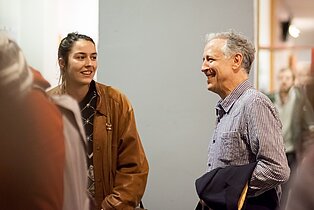Review | Marcelo Ferraz at the November Talks 2017 in Paris
As a native of Brazil, a country with radical cultures, Marcelo Ferraz had already established a close connection to the past in his first drawings. Inspired by travel reports and engravings by Theodor de Bry, which tell of cannibalistic tribes, the avant-gardism of Diego Rivera or the bold modernism of Oscar Niemeyer, Marcelo developed a style with a characteristic feature: the balance of tradition and breaking with the past.
Constructed architecture does not exist without context, which could be defined as the organic sum of culture, knowledge, locations and resources. It is the innate wealth of a country that one can make use of when putting in the effort of seeing, hearing and understanding it. There is a typically Brazilian concept of heritage that can be described using the words of Lucio Costa: “A harmonious coexistence of epochs, materials, cultures, traditions…” Heritage is the legacy of humans – shaped by their riches and suffering – and to honour it is both an act of remembrance as well as one of forgetting.
In this regard, Marcelo’s meeting with Lina Bo Bardi in 1977 was a crucial event. At the time, the latter had begun the construction of SESC Pompeia, which she completed in 1982. An interplay of relentless accuracy of volumes and the irregularity of openings, the strictness of rough concrete bridges and the markings of the timber formwork, a new brutalism at the intersection of tradition and rationality, of craftsmanship and precision. In this case, the architectural poetry seemed to be the result of imperfection.
Because Marcelo Ferraz understands architecture as a type of work with impressions and rational elements. All architects can draw a rational plan, but how many of them are able to provide it with a sense of indescribable detailed work, from the effort of selecting materials or the type of implementation? How many of them can manage to create this subtle dialogue between the historic essence of a place and current needs? Just like Carlo Scarpa, Marcelo grapples with history and ensures its continuity by allowing it to become part of his work. His humility toward history provides his architecture with the picturesque character of local buildings, his avant-gardism and modernism provide it with constructive rationality, and the means of implementation provides it with a subtle imperfectness that is viewed as an homage to craftsmanship and manual labour.
Brazil is a gigantic, unstable country. Marcelo and his agency take jobs in all parts of the country which, in some cases, require a new approach. The projects presented as part of the lecture make clear which enormous attention has been dedicated to the context, the many challenges and the solutions that the agency of Ferraz developed in order to meet them.
Cultural challenges.
Visitors of the Bread Museum are experiencing an interplay of materials. This project was about the renovation of a mill built by an Italian family that wanted to establish a timber business in Brazil. In this case, Marcelo Ferraz used wood, glass, fabric, concrete and stone that were exclusively manufactured locally. The architecture adapts to the traditional local context.
Dialogue between old and new.
The Pampa Museum is another example of the continuity between past and present. As much of the former military building as possible was retained, and the new building part was added to it. Cast concrete covered with wooden slats comes into contact with the massive stones of the arsenal and thereby creates strong visual impressions thanks to the contrast of materials of a different nature.
Using traditional know-how
The seat of the Instituto Socioambiental (ISA) is another homage to local traditions. In this project, the architect relied on the participation of the local population for the completion of the roof of the building, which consists of woven bamboo, vines and twigs. The same holds true for his best-known project, the Praça Das Artes cultural centre. Here, he asked craftsmen to equip the common rooms with a fabric cover and chandeliers. In this case, Ferraz took up something universal: the immanent riches of old, deeply rooted traditions in the service of a mixed project. Old cultures meet modern awareness.
While the idea of a tabula rasa is very tempting for modern, contemporary architecture, Marcelo Ferraz and his agency decided to pursue the opposite: A construction project is not some insignificant act, and it has to be implemented intelligently and with modesty. The architecture of the agency Brazil Arquitetura Studio is visionary because it is not just aware of the current challenges and the development of its country, but it also features an astute memory that respects the past. Brazil is a country on the move – halfway between its thousand-year roots and its complete industrialisation: So it chose the best of each and accepted the advantages and drawbacks of both. And that might be the secret of the visual, symbolic power of the architecture of Marcelo Ferraz. Maybe expressing timelessness requires a different vision of time – one that is no longer viewed as a series of events, but rather as a network, as Lina Bo Bardi said: “Linear time is a Western invention; time is not linear, it is a marvellous tangle where at any moment points can be selected and solutions invented without beginning or end.”
Interview with Marcelo Ferraz
The Video can be found on our YouTube-Channel.












